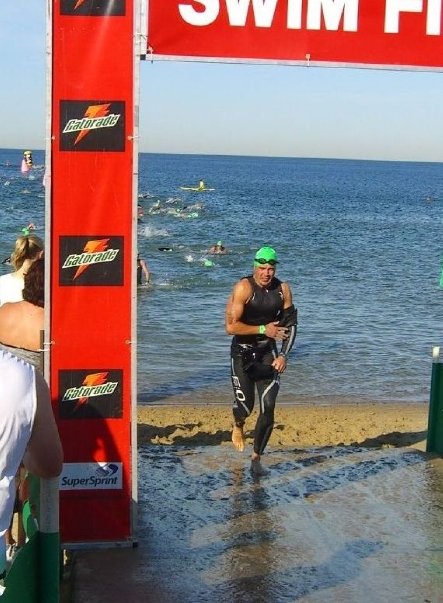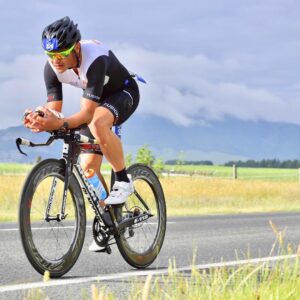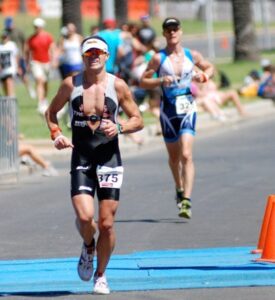A discussion about Injury differences in Short vs Long course Triathletes
By Sports & Exercise and Olympic Physio, Britt Caling
 Triathlon is competed over varying distances from Sprint (750m swim, 20km bike, 5km run, or even shorter introductory races), to Olympic distance (1.5km swim, 40km bike, 10km run) to Ironman (3.8km swim, 180km bike, 42.1km run) and even Ultraman distances. Most Triathletes tend to focus on a specific competition distance and the Injury Incidence and most common site of Injury tends to vary depending on this focus.
Triathlon is competed over varying distances from Sprint (750m swim, 20km bike, 5km run, or even shorter introductory races), to Olympic distance (1.5km swim, 40km bike, 10km run) to Ironman (3.8km swim, 180km bike, 42.1km run) and even Ultraman distances. Most Triathletes tend to focus on a specific competition distance and the Injury Incidence and most common site of Injury tends to vary depending on this focus.
Overall research literature reports 50- 75% of competitive triathletes will experience at least 1 injury in a 1 year period. The most common regions of injury in triathletes are the knee, low back and then shoulder. Olympic distance athletes tend to experience more knee-related injuries, while Ironman triathletes have a greater incidence of low back injury/pain.
A greater number of hours trained per week results in an increased likelihood of experiencing an overuse injury. With long course triathletes tending to train more hours per week, they have a greater risk of injury, with 75% of Ironman Triathletes reporting an injury that disrupted training, racing or required medical assessment (Burns et al 2003; Korkia et al 1994; Egermann et al 2003).
Vleck et al (2010) also reported that Olympic Distance triathletes had a higher tendency for Achilles injury which may be due to increased hill and speed training undertaken by these athletes, compared to the lower and longer training intensities performed by long-course triathletes.
 A study from athletes competing in the 2006 Australian Ironman (Ansell , 2012) found 86.1% reported suffering an overuse injury related to competition or training in the last year. The most common site of injury in this survey was the knee (35.1% of respondents), followed by the low back (34.1%) and the ankle/foot (30.7%). Low back injuries had a significant association with the cycling discipline. This is likely in long course athletes given the increased number of training and racing hours spent on the bike, and in particular the amount of time spent in the aerodynamic position which places the lumbar spine and hips in a large amount of flexion and increases force in the intervertebral discs and across the lumbar spine-to-sacrum junction. Cycling is also an activity using concentric (muscle shortens when it contracts) muscular contractions and obviously doesn’t expose the athlete to the ground reaction forces that running does. Running also requires eccentric muscle contractions (muscle lengthens as it contracts) and the ability of the lower limb to absorb and transmit forces adequately. Prolonged cycling may reduce the capacity of the athlete to adapt to the changed forces that they must deal with when running, so also result in increased injuries in the run discipline.
A study from athletes competing in the 2006 Australian Ironman (Ansell , 2012) found 86.1% reported suffering an overuse injury related to competition or training in the last year. The most common site of injury in this survey was the knee (35.1% of respondents), followed by the low back (34.1%) and the ankle/foot (30.7%). Low back injuries had a significant association with the cycling discipline. This is likely in long course athletes given the increased number of training and racing hours spent on the bike, and in particular the amount of time spent in the aerodynamic position which places the lumbar spine and hips in a large amount of flexion and increases force in the intervertebral discs and across the lumbar spine-to-sacrum junction. Cycling is also an activity using concentric (muscle shortens when it contracts) muscular contractions and obviously doesn’t expose the athlete to the ground reaction forces that running does. Running also requires eccentric muscle contractions (muscle lengthens as it contracts) and the ability of the lower limb to absorb and transmit forces adequately. Prolonged cycling may reduce the capacity of the athlete to adapt to the changed forces that they must deal with when running, so also result in increased injuries in the run discipline.
 In Ironman triathlon, dehydration and hyponatraemia are common conditions to be aware of (58-72% of athletes) and are significant factors affecting race performance, more so than in short course racing. Dehydration is a loss of water due to excess sweating and may cause cramps, exhaustion and hyperthermia. Laird (1989) reported 71% of the athletes requiring medical care in long course triathlon was at the finish line and was for dehydration and exhaustion-related factors. Hyponatremia is a medical condition where the concentration of sodium in the blood falls to less than 135mmol/L. The most common cause of this is excess consumption of water that dilutes the concentration of sodium and places the kidneys under significant stress. This can become a significant medical condition resulting in confusion, nausea, fatigue and in the worst cases seizures, coma, pulmonary oedema and possible death. The incidence of Hyponatremia in short course racing is very low.
In Ironman triathlon, dehydration and hyponatraemia are common conditions to be aware of (58-72% of athletes) and are significant factors affecting race performance, more so than in short course racing. Dehydration is a loss of water due to excess sweating and may cause cramps, exhaustion and hyperthermia. Laird (1989) reported 71% of the athletes requiring medical care in long course triathlon was at the finish line and was for dehydration and exhaustion-related factors. Hyponatremia is a medical condition where the concentration of sodium in the blood falls to less than 135mmol/L. The most common cause of this is excess consumption of water that dilutes the concentration of sodium and places the kidneys under significant stress. This can become a significant medical condition resulting in confusion, nausea, fatigue and in the worst cases seizures, coma, pulmonary oedema and possible death. The incidence of Hyponatremia in short course racing is very low.
As a Sports & Exercise Physio who has worked with the elite Australian Triathlon Team since 2002, I have a bias towards seeking and regularly using experienced allied health therapists (ie. Physio, Massage, Sports Dietitian, Podiatry, Osteopathy etc) to help reduce your Injury risk when triathlon racing. An experienced Sports Therapist that understands the demands of Triathlon as a sport will be able to help identify the intrinsic and extrinsic risk factors for you as an individual triathlete. It is also interesting to note that the survey by Ansell from the Australian Ironman found that athletes with a triathlon coach had a lower injury rate than athletes that were self-coached. This highlights the benefit of having a Coach as part of your training team, as well as Sport Therapists that have a specific understanding of the needs of you as a Triathlete.
At Gold Coast Physio & Sports Health, we have multiple staff who are, or have been competitive triathletes so we understand your needs specifically. Call us on 07 5500 6470 or book an appointment online at www.mygcphysio.com.au

































